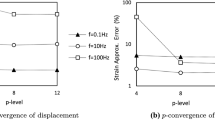Abstract
This paper deals with investigation of diffusion for p-version least squares finite element formulation (LSFEF) and p-version space-time coupled least squares finite element formulation (STLSFEF) for steady-state and transient problems. Convection dominated flows result in hyperbolic system of equations which leads to ill-conditioned matrices when using Galerkin formulation. Various techniques (SUPG, SUPG-with discontinuity capturing operator etc.) have been devised to overcome the difficulties arising primarily due to hyperbolic terms and sharp gradients. In this paper, it is demonstrated that when using p-version STLSFEF or LSFEF, no such difficulties are encountered in formulation as well as in the solution procedure. Almost all numerical processes suffer from numerical diffusion to some extent, however, it is demonstrated in this paper that in p-version STLSFE and LSFE formulations numerical diffusion can be completely eliminated by mesh refinement and p-level increase and the formulations are free of inherent diffusion. Several model problems are considered with dominant convective terms to investigate diffusion in p-version LSFEF and STLSFEF. Two dimensional convection-diffusion problems are used as steady state representative cases. One dimensional transient problems considered in this paper include pure advection, convection-diffusion and Burgers' equation. Numerical results are also compared with exact solutions and those reported in the literature.
Similar content being viewed by others
References
Bell, B.; Surana, K. S. 1993: A p-version space-time coupled LSFEF for two dimensional unsteady Newtonian fluid flow. ASME Winter Annual Meeting, New Orleans, LA, Nov. 28–Dec. 3, 1993
BellB.; SuranaK. S. 1994a: p-version least squares finite element formulation for two dimensional, incompressible, non-Newtonian isothermal and non-isothermal fluid flow. Int. J. for Num. Meth. in Fluids 11: 127–162
BellB.; SuranaK. S. 1994b: A space-time coupled p-version LSFEF for unsteady fluid dynamics. Int. J. for Num. Meth. in Engg. 37: 3545–3569
BrooksA. N.; HughesT. J. 1982: Streamline upwind/Petrov-Galerkin formulation for convection dominated flows with particular emphasis on the incompressible Navier-Stokes equations. Comp. Meth. in Appl. Mech. and Engg. 32: 199–259
CareyG. F.; PloverT. 1983. Variable upwinding and adaptive mesh refinement in convection-diffusion. Int. J. of Num. Meth. in Engg. 19: 341–353
ChristieJ.; GriffithsD. F.; MitchellA. R.; ZienkiewiczO. C. 1976: Finite element method for second order differential equations with significant first derivatives. Int. J. of Num. Meth. in Engg. 10: 1389–1396
ChristieJ.; MitchellA. R. 1978: Upwinding of higher order Galerkin Methods in Conduction-Convection problems. Int. J. of Num. Meth. in Engg. 12: 1764–1771
EdgarN. B.; SuranaK. S. 1994: p-version least squares finite element formulation for axisymmetric, incompressible, non-Newtonian fluid flow. Comp. Meth. in Appl. Mech. and Engg. 113: 271–300
FrancaL. P.; FreyS. L.; HughesT. J. R. 1992: Stabilized finite element methods: I. Application to the advection-diffusion model. Comp. Meth. in Appl. Mech. and Engg. 95: 253–276
GrygielJ. M.; TanguyP. A. 1991: Finite element solution for advection dominated thermal flows. Comp. Meth. in Appl. Mech. and Engg. 93: 277–289
HeinrichJ. C.; HuyakornP. S.; ZienkiewiczO. C.; MitchellA. R. 1977a: An upwind finite element scheme for two-dimensional convective transport equations. Int. J. for Num. Meth. in Engg. 11: 131–143
HeinrichJ. C.; ZienkiewiczO. C. 1977b: Quadratic finite element schemes for two-dimensional convective-transport problems. Int. J. for Num. Meth. in Engg. 11: 1831–1844
HeinrichJ. C. 1980. On quadratic elements in finite element solution of steady-state convection diffusion equation. Int. J. for Num. Meth. in Engg. 5: 1041–1052
Hughes, T. J. R.; Atkinson, J. 1978: A variational basis for ‘upwind’ finite elements. IUTAM Symposium on Variational Methods in the Mechanics of solids, Northwestern University, Evanston, IL
HughesT. J. R. 1978: A simple scheme for developing ‘upwind’ finite elements. Int. J. for Num. Meth. in Engg. 12: 1359–1365
HughesT. J. R.; MalletM. 1986a: A new finite element formulation for computational fluid dynamics: III. A gereralized streamline operator for multidimensional advection diffusion systems. Comp. Meth. in Appl. Mech. and Engg. 58: 305–328
HughesT. J. R.; MalletM.; MizukamiA. 1986b: A new finite element formulation for computational fluid dynamics: II. Beyond SUPG. Comp. Meth. in Appl. Mech. and Engg. 54: 341–355
HughesT. J. R.; MalletM. 1986c: A new finite element formulation for computational fluid dynamics: IV. A discontinuity-capturing operator in multi-dimensional advection diffusion systems. Comp. Meth. in Appl. Mech. and Engg. 58: 329–336
KellyD. W.; NakazawaS.; ZienkiewiczO. C.; HeinrichJ. C. 1980: A note on upwinding and anisotropic balancing Dissipation in finite element approximations to convection diffusion problems. Int. J. of Num. Meth. in Engg. 15: 1705–1711
LiC. W. 1990: Least-squares characteristics and finite elements for advection-dispersion simulation. Int. J. for Num. Meth. in Engg. 29: 1343–1358
Oden, J. T. 1969: A Generalized Theory of Finite Elements Parts I and II. Int. J. for Num. Meth. in Engg. 205–221, 247–259
RichtmyerR. D.; MortonK. W. 1967: Difference Methods for Initial-value problems, 2nd ed. Interscience, New York
RoacheP. J. 1972: Computational fluid dynamics. Hermosa Publishers, Albuquerque, New Mexico
SuranaK. S. 1994a: Finite Element Method in Fluid Dynamics-ME 963 Lecture Notes, University of Kansas, Lawrence, Kansas
SuranaK. S. 1994b: FINESSE (Finite Element System) User's Manual, University of Kansas, Lawrence, Kansas
Tezduyar, T. E.; Hughes. T. J. R. 1983: Finite element formulations for convection dominated flows with particular emphasis on Compressible Euler equations. AIAA paper 83-0125, proceedings of AIAA 21st Aerospace Science Meeting, Reno, Nevada
TezduyarT. E. 1991: Stabilized finite element formulations for incompressible flow computations. Advances in Appl. Mech. 28: 1–44
WinterscheidtD.; SuranaK. S. 1993a: p-version least squares finite element formulation for convection-diffusion problems. Int. J. for Num. Meth. in Eggg. 36: 111–133
WinterscheidtD.; SuranaK. S. 1993b: p-version least squares finite element formulation of Burgers' equation. Int. J. for Num. Meth. in Engg. 36: 3629–3646
WinterscheidtD.; SuranaK. S. 1994: p-version least squares finite element formulation for two-dimensional, incompressible fluid flow. Int. J. for Num. Meth. in Fluids 18: 43–69
Author information
Authors and Affiliations
Additional information
Communicated by S. N. Atluri, 15 February 1995
Rights and permissions
About this article
Cite this article
Surana, K.S., Sandhu, J.S. Investigation of diffusion in p-version ‘LSFE’ and ‘STLSFE’ formulations. Computational Mechanics 16, 151–169 (1995). https://doi.org/10.1007/BF00369778
Issue Date:
DOI: https://doi.org/10.1007/BF00369778




